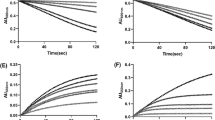Abstract
The phosphorylation of deoxyguanosine was measured in fractured and intact mitochondria and an apparent Km of 16 μM for deoxyguanosine was calculated using fractured mitochondria. The effects of various deoxynucleotides on the phosphorylating activity in fractured organelles was tested at both a high and low ratio of NXP/ATP and at two pH values, 7.0 and 5.5. Exogenous dGTP, dGDP or dITP were inhibitory under all conditions tested. With a NXP/ATP ratio of 0.08 at pH 7.0, TTP, TDP, dADP, ADP, UTP and UDP were stimulatory, but at pH 5.5 only TTP elicited that response. When the NXP/ATP ratio was 10 at pH 5.5, TTP and UTP increased the activity more than 10-fold, whereas, at pH 7.0 TTP, TDP, dADP, ADP, UTP, UDP caused stimulation, but to a much lesser extent. When exogenous Mg2+, Mn2+ or Ca2+ were added to intact mitochondria, the rates of phosphorylation were lowered. In fractured mitochondria in the absence of exogenous ATP, little phosphorylation occurs, hence these metal ions caused little change. ATP-Mg, ATP-Mn and ATP-Ca, each at 0.05 mM caused a small inhibition with intact mitochondria, whereas, these compounds supported phosphorylation with fractured organelles. ATP-Mn (10 mM) or ATP-Ca (10 mM) stimulated phosphorylation in both intact and fractured mitochondria. Intact mitochondria synthesized dGMP, dGDP and dGTP when metal ion or ATP-Me concentrations were low (0.05 mM) or when Mg2+ concentration was high (10 mM). Additions of ATP-Ca, ATP-Mn, ATP-Mg, Mn2+ or Ca2+ at 10 mM cause the loss of dGDP and dGTP formation and, in most cases, an increase in the synthesis of dGMP. Fractured mitochondria make only dGMP and the levels of its synthesis are greater than that observed for intact mitochondria. These data suggest that intact mitochondria are required for the synthesis of dGTP and that its synthesis is regulated by mitochondria nucleotides.
Similar content being viewed by others
References
Berk AJ, Clayton DA: A genetically distinct thymidine kinase in mammalian mitochondria. J Biol Chem 248:2722–2729, 1973
Cheng Y, Domin B, Lee L: Human deoxycytidine kinase. Purification and characterization of the cytoplasmic and mitochondrial isozymes derived from blast cells of acute myelocytic leukemia patients. Biochim Biophys Acta 481:481–492, 1977
Gower WR, Jr, Carr MC, Ives DH: Deoxyguanosine kinase. J Biol Chem 254:2180–2183, 1979
Greger J, Fabianowska-Majewski K, Gorzkiewicz B: Purification and properties of deoxyadenosine kinase from rat liver mitochondria. Enzyme 31:33–38, 1984
Leung WC, Dubbs DR, Trukula D, Kit S: Mitochondrial and herpes virus specific deoxypyrimidine kinase. J Virol 16:486–497, 1975
Greger J, Fabianowska K: Relationship between 5′ nucleotidase, adenosine deaminase, AMP deaminase, ATP(Mg2+)ase activities and dTMP kinase activity in rat liver mitochondria. Enzyme 24:54–60, 1979
Tsiftsoglou AS, Georgatsos JG: Metabolism of nucleosides by isolated mouse liver mitochondria. Biochim Biophys Acta 262:239–246, 1972
Glaze RP, Wadkins CL: Properties of a nucleoside diphosphokinase from liver mitochondria and its relationship to the ATP/ADP exchange reaction. J Biol Chem 242:2139–2150, 1967
Pedersen PL: Coupling of ATP formation in mitochondria to the formation of nucleoside triphosphates; involvement of nucleoside diphosphokinase. J Biol Chem 248:3956–3962, 1973
Lewis RA, Watkins LF: Phosphorylation of deoxyguanosine in rat liver mitochondria. In: De Bruyn CHMM, Simmonds HA, Mullese MM (eds) Purine Metabolism in Man, IV. Pt. B, Plenum Press, 1984, pp 79–82
Chappell JB, Hansford RG: Preparation of mitochondria from animal tissues and yeasts. In: Bernie GD (ed) Subcellular Components, Preparations and Fractionation. 2nd Ed, Butterwork, London, 1972, pp 77–91
Watkins LF, Lewis RA: The metabolism of deoxyguanosine in mitochondria: a characterization of the phosphorylation process which occurs in intact mitochondria. Biochim Biophys Acta 923:103–108, 1987
Apprille JR, Austin J: Regulation of the mitochondrial adenine pool size. Arch Biochem Biophys 212:689–699, 1981
Tzagoloff A: Mitochondria. In: Siekevitz P (series ed) Cellular Organelles. Plenum Press, New York, 1982, pp 199–233
Author information
Authors and Affiliations
Rights and permissions
About this article
Cite this article
Watkins, L.F., Lewis, R.A. Phosphorylation of deoxyguanosine in intact and fractured mitochondria. Mol Cell Biochem 77, 153–160 (1987). https://doi.org/10.1007/BF00221924
Received:
Accepted:
Issue Date:
DOI: https://doi.org/10.1007/BF00221924




